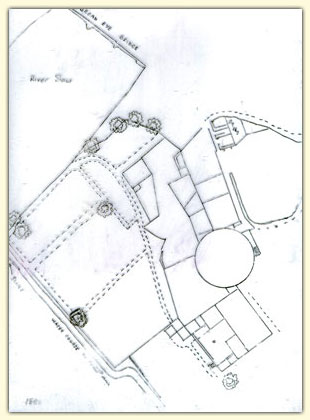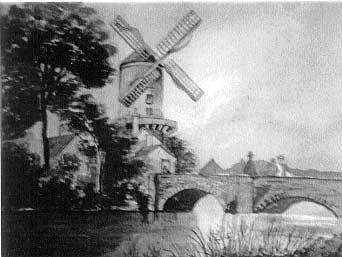
A history of Broad Eye Windmill, Stafford (abridged version)
Introduction.
Broad Eye Windmill is to be found in Castle Hill, on the eastern bank of the River Sow just south of the Doxey road bridge. The windmill and adjacent properties were built on land owned by Stafford Corporation, now called Stafford Borough Council. At the time of its construction there were probably no houses between the windmill and Stafford castle, the nearest ones being in the hamlet of Doxey to the north west of the town.
Initially the site comprised the windmill and five cottages. There were, in addition, a garden and two pig sties in front of the northern cottages and small allotments to the rear of all the cottages that reached down to the river. Water for the site was drawn from a well in the yard behind the windmill. A brick surfaced yard ran behind the cottages.

Why build a windmill close to the town
For a great many years the town has, periodically, suffered from flooding. Present day residents may have seen some of this for themselves. In the late 18th Century members of Stafford Corporation, the predecessors of the present Borough Council, formed the opinion that this flooding could be prevented if the watermills then taking their water supply from the River Sow could be closed down. It was alleged that the millers failed to dredge their mill ponds and sluices regularly as in the term of their leases, and that they were responsible for the flooding. It was true that in times of heavy rain the rising of water did not drain away easily, especially in the vicinity of the watermills. However, as the townsfolk depended on these water mills for their flour an alternative source would have to be offered. The Aldermen decided that the solution would be to build a windmill, close to the centre of the town, and force the closure of the watermills. The population would then have to use the Corporation’s windmill.
(left; early plan of the Mill and surrounding area)
There were two problems with this
The Corporation did not have the funds to pay for a windmill (indeed they did not have sufficient funds available to meet their existing commitments which included contributing £1000 to the rebuilding costs of the Elizabethan Shire Hall that once stood in the centre of what is now the Market Square). The Shire Hall was pulled down in 1794 in preparation for its rebuilding on the site – as we see it today. In addition, the Corporation could not just close down the watermills, this would require an Act of Parliament; obtaining one was not a quick process and would be costly.
The Corporation thought that their problems were resolved in October 1795, when they agreed that the Town Clerk, Francis Brookes, and the Corporation’s banker, John Wright, should be given a lease on the land at Broad Eye where the windmill would be built and it authorised to them to go ahead and build the mill. Initially a 99 year lease was agreed, commencing on Lady Day, 25th March 1796, in consideration of a payment to the Corporation of a third of the money required to meet their contribution to Shire Hall rebuilding costs (about £350). However, when the Corporation found that they still could not raise the additional funds, the lease was extended to one of 500 years to secure a further third of the amount required. The Corporation raised the remainder of the sum required to fulfill their commitment to the Shire Hall project by Mr Wright making a loan of the balance in exchange for a security, namely a tithe barn and associated lands (location not known). Records suggest the loan was never repaid.
Granting this lease required the Corporation to close down the allotments that stood on the proposed site at Broad Eye on the land adjacent to the river, downstream of Doxey bridge. The tenants affected were formally given notice to quit despite their having leases for the land, but there was ill feeling about this!
It took the Corporation another forty years (1835) to secure the Act of Parliament. The only mill they succeeded in closing was the watermill at St Thomas Priory. The watermill said to have been in the Eastgate Street area had already fallen into ruin by then. More recent archaeological digs suggest that the mill might have been under what is now Asda. No records have been seen to suggest that the action of the Corporation solved the flooding problem. One advantage, so far as Broad Eye windmill’s history is concerned, was that the Corporation was required to produce an accurate detailed map of the town to support its request to Parliament. This was published in 1835.
Construction
The name of the millwright employed is not known; however, it is unlikely that there would have been architectural drawings, instead the millwright would have built the windmill according to custom and practice and his own experience. He obviously worked with considerable speed because the Staffordshire Advertiser reported that the windmill, which had two pairs of common sails and 2 pairs mill stones, was operational by the same autumn (1796).

Doxey
Bridge and windmill in 1820's
The windmill appears to have been constructed from recycled materials. The stone, and some of the hard wood timber came from the Elizabethan Shire Hall that stood where the Market Square is today. The Shire Hall was demolished in 1794. Sixteenth century timber has been identified in the mill. Some brickwork was also used inside the tower to support the beams. There were seven floors but only the upper four floors were used for flour production until about 1840.
The stone tower is 17.00m (55.77 feet) high but the total height to the top of the cap is 19.4m (63.77 feet), making this probably the tallest tower mill in the Midlands. It seems probable that the windmill was built to this height to compensate for its low level location.
The tower was roofed with a wooden conical cap similar in appearance to that to be seen today. This cap was clad with wooden shingles. In this cap, which could be turned to face the wind, was mounted the sails, windshaft and sail mechanism.The reefing gallery or stage would have been at the fourth floor level. From this staging, the miller would have stretched canvas upon the sails. Clearly the sails would not have posed a hazard to those walking in the street below because they did not reach down below the reefing stage.
Research suggests that the stone was most likely to have been quarried at Kingston Hill and Tixall and that some of the timber came from Penkridge and Blore Park. Many of the joists and beams, identified as being of 16th century timber, have ovolo mouldings similar to those in the Ancient High House.
Post construction developments
As the population of Stafford grew so did the demand for flour. With the arrival of the railway and the construction of Castletown, the need for additional pairs of millstones and more power was apparent. It was decided, at some time between 1835 and 1847 to install a steam engine at the mill so that the grinding process could continue when there was insufficient wind to turn the sails. An engine house was built on the river-side of the tower. To make room for this building the three cottages on the north side were demolished and rebuilt in the position seen today. The engine house was built over the well that supplied the site. Water could still be drawn from this well as late as the 1950s.
The first steam engine is believed to have been a beam engine, known colloquially as ‘a nodding donkey’ engine. When this proved inefficient a 16-horse power horizontal steam engine was installed on the first floor. John Smith of the village foundary, Coven, 1827 - 1879, built the second steam engine. This drove an additional three pairs of grinding millstones on the 2nd floor. The engine house chimney stood 60 feet tall, almost as high as the top of the windmill.
The mill could now operate whenever flour was required and did not depend on wind strength. In effect there were two flour mills operating within the tower, the upper one wind powered, the lower one steam driven. Grain for both mills was stored at third floor level. Thus, between 1850 and the mid 1860's, seven pairs of millstones could be worked simultaneously.
During its life as a windmill many additions were made to the site, a bakery was built adjacent to the river, behind what is now an antiques business. The northern cottages became commercial premises with living accommodation on the upper floors. The miller and baker employed some of the cottage residents.
In the ensuing years many modifications were made to keep the milling viable including, latterly, animal feed production. However, production could not keep pace; when people requested white flour of a higher quality than was produced by stone grinding, demand could not be matched with the production by roller mills. The production of flour came to halt in 1886. When milling ceased the sails and machinery were removed and the tower converted to a warehouse, the last miller being Ralph Bullock Wright, who emigrated to New York that year.
It is not known when gas lighting was installed but there is evidence of this reaching up to the fourth floor. There was an external gas light over the shop front, the pipework of which can be seen to this day. Electricity was not introduced until 1996 when the "Friends" took over.